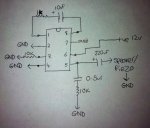Hello all,
I've got all the hardware ready for the alarm system I'm building, apart from the amplifier for my Tenda MP3 module which is to be used as a voice enhanced sounder. If any of you use the SD variant of Tenda's MP3 module then you may know how quiet the unit is with a piezo connected. Well mine is anyway
This is why I added an LM386 configured to have a 200 gain. Still, it isn't loud enough (I can talk over the audio). I need something that outputs 'double' of this LM386, perhaps around 90db.
I was wondering if anyone knows of any amplifier IC's that I can swap with my LM386 to get my 90db?
Tried doing a google search but got nothing helpful.
I've got all the hardware ready for the alarm system I'm building, apart from the amplifier for my Tenda MP3 module which is to be used as a voice enhanced sounder. If any of you use the SD variant of Tenda's MP3 module then you may know how quiet the unit is with a piezo connected. Well mine is anyway
This is why I added an LM386 configured to have a 200 gain. Still, it isn't loud enough (I can talk over the audio). I need something that outputs 'double' of this LM386, perhaps around 90db.
I was wondering if anyone knows of any amplifier IC's that I can swap with my LM386 to get my 90db?
Tried doing a google search but got nothing helpful.

